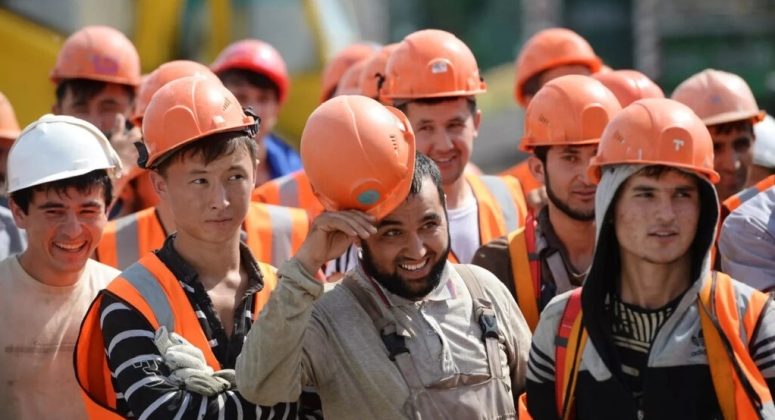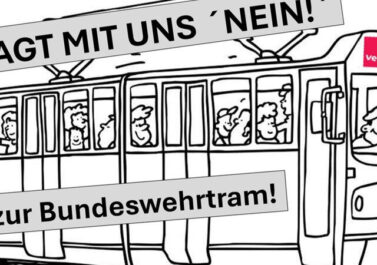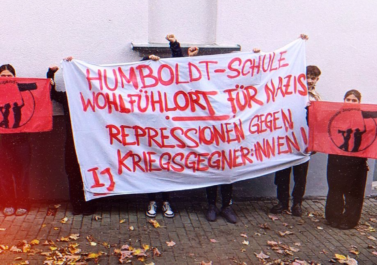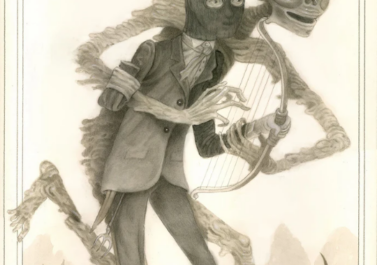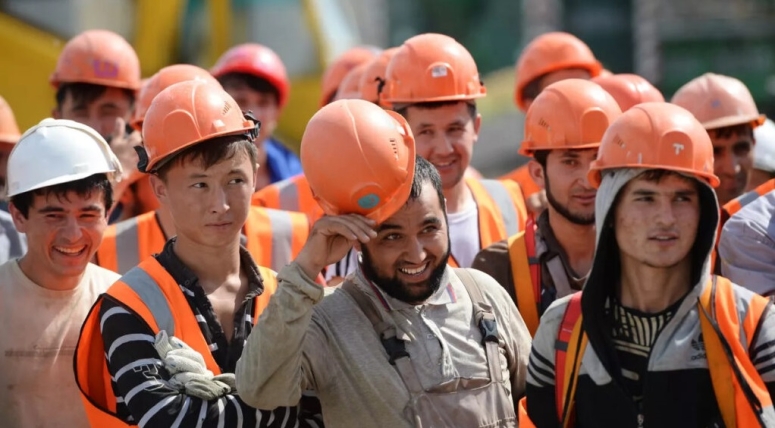
Translation of an article by Jarosław Urbański, Polish original can be found on the Workers’ Initiative (IP) website here. We might not agree with all formulations, e.g. whether we deal with a capitalist or non-capitalist character of the Soviet Union before 1990, but think that the text provides important insights when it comes to the fragile class relations in Russia today.
The outbreak of increased hostilities in Ukraine in February 2022 has renewed global public interest in the economic situation of the Russian Federation (RF) – particularly in the context of oil and gas exports, arms financing and the consequences of Western-imposed sanctions. However, it is also worth asking how the situation of workers in Russia has changed. What does workers’ structural and organisational bargaining power look like at the moment? And will the current crisis result in mass uprisings against the war and Putin’s power?
Since the collapse of the Soviet Union (USSR), the Russian economy has definitely ‘shrunk’. At its peak, the USSR accounted for nearly 13% of global GDP, with the so-called ‘socialist bloc’ countries adding to this. Today though, the Russian Federation accounts for a mere 1.7% of global GDP, placing its economy far outside the top ten largest economies – after the USA, China, Japan, India, some EU countries, etc. There is, therefore, a certain inconsistency in perceptions of the position of the Russian economy in the global context. Originally, Russia appeared as a contender for global hegemony, but was reduced to an essentially peripheral position. Aspirations persisted, but in reality, little of the superpower character remained.
At the same time, the Russian Federation is still a huge and economically and geographically diverse country, whose labour market is 4-5 times larger than the Polish one. It is also intrinsically linked to the situation of workers from the Central Asian countries: several million labour migrants working in the Russian labour market come from there.
Collapse and de-industrialisation
The peculiarities of the labour market in Russia today were determined by several important structural changes that took place back in the late Soviet era. Following the intensive industrialisation of the Stalinist period, the Soviet power elite began to attribute increasing importance to the energy and mining sector (coal, oil, gas). This was made possible primarily by the resources in Siberia. At the same time, keeping pace with the West in the technological race in other fields was becoming increasingly difficult. As the importance of hydrocarbon production and the money flowing into the state budget from its exports grew, so did the dependence of the rest of Soviet industrial production on imports (technology, components, machinery, etc.). The significant fall in oil prices in the second half of the 1980s created additional problems for the USSR’s economy and contributed to the break-up of the Union.
The 1990s and the transition in Russia are remembered as a complete economic catastrophe. In addition to a radical decline in GDP and real wages (compounded by the nightmare of massive wage arrears), a wide sphere of poverty was created and widespread corruption, crime and alcoholism emerged. There has been a spontaneous de-industrialisation of the country, resulting in an 11 million drop in employment in Russian industry from 1990 to 2015. In agriculture, an additional 4 million people have lost their jobs. Employment in the informal sectors of the labour market (excluding code contracts) grew to 14.6 million workers (which today accounts for about one-fifth of the total labour market). It is worth noting that these figures are almost the same size as the entire Polish labour market.
Vladimir Putin’s takeover of power in 1999 was paralleled with the high rise in fuel prices on international markets, which in turn improved the economic situation – especially the federal budget. In the most recent period, between 30% and 60% of state revenues were linked to the sale of hydrocarbons – to internal and external markets. (The percentage depends, among other things, on international market prices and the way it is counted: only direct or indirect benefits). The first years of Putin’s rule are associated with a significant improvement – relative to the 1990s – in that the material situation improved for many people in Russia: there was an increase in domestic consumption, as well as falling unemployment, low taxes and the retention of some of the social benefits introduced under the USSR. The price of this has been the maintenance of a hierarchical power structure and growing social inequalities. The processes of democratisation of the political system, launched under Yeltsin, came to a halt. With regard to the world of work, for example, strike laws were tightened and the labour code was amended. Government propaganda became very important. And so on.
The money flowing in from the sale of oil and gas and some other natural resources (e.g. metals, coal) was accumulated into the coffers of a narrow class of Russian oligarchs and decision-makers. However, the accumulated funds (financial reserves) were not allocated in sufficient quantity for extensive investment in technological development and the industrial sector, which had declined in the 1990s. Ultimately, the period of Putinist prosperity did not translate into radical structural changes in the labour market either. Precarisation – at a level similar to or even exceeding that seen in Poland – was its dominant feature.
What are the characteristics of the labour market in Russia?
The USSR was associated with an economy of full employment and stability, to the point of chronic labour shortages and forced employment. After the transition and the ‘introduction’ of capitalism [our inverted commas], the exact opposite trend took place in Russia. Informal and precarious forms of employment began to characterise the labour market. Although the concept of ‘precarisation’ is somewhat variable and also depends on the legal framework of the labour regime in each country, some Russian studies report that more than half of the hired labour force in Russia is precarious, or to use Marx’s language, function within the ranks of the ‘reserve army of labour’.
Firstly, this includes those dismissed from restructured and liquidated state-owned industrial plants, who have had to take up employment in other sectors of the labour market (e.g. services), often below their qualifications and on far worse conditions. Added to this are the considerable group of people who have lost their jobs in agriculture in Siberia and the Far East. This loss has affected up to 60-80% of jobs.
Secondly, labour migrants, primarily from Central Asian countries, account for a relatively large share (10-11%) of the Russian labour market. An additional feature is internal migration (another 10.6%) due to the large economic differences between the different regions of Russia.
Thirdly, there is the trend of unemployment and underemployment. It should be noted that, especially during the Putin era, the Russian labour market is characterised by an exceptionally low level of registered unemployment (currently around 4%). However, in the event of an economic downturn, it is customary in this system not to fire people outright, but to direct workers to part-time employment, unpaid leave, and finally to reduce their paychecks.This is easier to do, as in many industries, the fixed components of wages account for only 50-60% of earnings.
Researchers and scholars of the Russian labour market agree that its important feature is the very low wages. In Polish Zloty (PLN) terms, they amount to around 2208 PLN per month gross (27.6 thousand roubles,) [roughly £400] in small and medium-sized enterprises, and 3496 PLN per month gross (43.7 thousand roubles,) [roughly £630] in medium and large enterprises. However, this does not tell us much if we do not know the price relationship. On the other hand, it is an undeniable fact that it is not only the existing oligarch class that embodies the high level of social inequality in Russia. There are large wage differences between different groups of wage earners – between the precariat and the salariat, between regions, positions, and finally industries. The salaries of the 10% best and worst earners in Russia differ by 13-16 times! In Poland (according to CSO data for 2020), it is ‘only’ 3.5 times. Male and female workers in Russia, compared to (not only) other European countries, work longer – 1983 hours per year (whereas in Poland people work 1848 hours a year; in Germany 1574 hours). At the same time, this situation is not only not improving compared to the early 1990s but is even getting worse.
Finally, the progressive decapitalisation of the means of production (i.e. deindustrialisation) makes working conditions deteriorate. An indicator here is the number of accidents at work and their reporting. Even though many accidents are not reported in Russia, we know that for every 22 non-fatal accidents, there is 1 fatal accident (which are more difficult to hide). In most European countries, the figure is between 400 and 2,000 accidents per 1 fatality (315 in Poland in 2021 according to the CSO). According to the International Labour Organisation, taking into account legal and definitional differences, this ratio should be 500-1000 cases per 1 fatality. Thus, it is unofficially estimated that 455,000 occupational accidents occur annually in Russia, when in 1990 there were 432,000 (officially 23,300 are reported, including 1060 fatalities – in 2019).
Trade unions
With the collapse of the USSR, deindustrialisation and then precarisation, there was a sharp decline in unionisation. In the system of the Eastern Bloc countries, trade unions focused on social welfare, protective and production-related tasks, writes Juliusz Gardawski: “They became the institution through which the authoritarian socialist state carried out many of the tasks of the welfare state”. They became depoliticised and de facto lost their independence, although in some cases they organised protests and competed with factory party cells. The vast majority of salaried workers functioned within their ranks, due in no small part to issues of securing certain subsistence needs.
In Russia, the successor of the post-Soviet unions was the Federation of Independent Trade Unions of Russia (FNPR)., They ‘inherited’ all the assets from the previous headquarters (the new headquarters received 21% of the assets, its regional structures the remaining 79%). In the mid-1990s, rival organisations emerged: The Confederation of Labour of Russia (KTR), All-Russian Confederation of Labour (VKT), Federation of Trade Unions of Russia (FPR), which, after some time, began to consolidate. Unification took place in 2010 (under the KTR banner). In the following years, the Union of Trade Unions of Russia (SPR) was formed.
At the beginning of the new century, the main headquarters (FNPR) – which at its inception had shunned Marxism-Leninism and later supported Putin and the war in Ukraine – was said to have a membership of 31.1 million, while other trade unions probably had around 3 million members. However, these figures were most likely inflated. In a representative survey that I took part in as a researcher (EUREQUAL) between 2006 and 2009, 12.4% of adults declared membership of Russian trade unions. If the reported membership figures were true – it would have to be around 25%. Unionisation (the percentage of union members among wage earners – according to official data) was then 18.4% in the Russian Federation, while in the same study for Poland it was 11.3%. The latest figures show that 20 million people still belong to the FNPR, and more than 3 million to other organisations.
Putin’s rule has also been associated with a decline in the importance of legal strikes as a weapon against exploitation. However, trade unionists argue that the forms of struggle have also changed and official figures do not reflect the real scale of protests. Fewer strikes, for example, are reported than actually occur. There is even independent monitoring of labour protests (by the Centre for Social and Labour Rights).
Why did war break out?
The second decade of Putin’s rule was associated with increasing economic difficulties. The Russian economy and hydrocarbon exports were first hit by the crisis of 2008, which led to a short-lived rise in unemployment (from 5.5% to around 9%). The recession reduced demand for fuel, so fuel prices fell. When they started to rise again (although there were also large fluctuations), the situation improved, but most analysts agree that the Russian economy has been gripped by stagnation ever since. Pressure for restrictions in the social sphere intensified, which triggered mass social protests. There were increasing demands for political reforms.
Already in 2004-2005, there were protests against the restrictions on certain social benefits (so-called monetarisation), and in 2006 there were protests against the increase in the price of communal services. However, this was only the beginning of a great wave of discontent that began to grow from the 2008 protests in response to the worsening economic situation in the country. Added to this were protests of a strictly political nature (2011-2012) against election rigging, corruption and demanding the release of political prisoners. Finally, a particular source of conflict was the issue of raising the retirement age. Mass protests on this issue took place between 2017 and 2019. It was finally decided that the retirement age would increase in stages: for women from 55 to 60 and for men from 60 to 65. Incidentally, FNPR MPs voted in favour of this law and against the interests of the working-class world.
Faced with concerns about support for Putin’s rule and uncertainty about further hydrocarbon exports (decarbonisation) and growing socio-economic tensions, the Russian elite took a course towards nationalist politics, supporting the Donetsk and Luhansk separatists in Ukraine and the annexing of Crimea in 2014. By appealing to Great-Russian resentments and through propaganda, they managed to keep Putin’s ratings relatively high in the polls, but the economic difficulties – especially in view of the outbreak of the COVID-19 pandemic in 2020 – could not be overcome. Incidentally, more than 390,000 people have so far died from coronavirus in Russia (in laboratory and clinically confirmed cases), although the real number of deaths is at least three times higher. By launching a full-scale war on 24 February 2022, Russia also hoped to strengthen its bargaining position in economic relations with Europe and the rest of the world. However, success was not achieved and the easy victory of 2014 was not repeated. Instead, the prolonged armed conflict exacerbated all the already existing socio-economic difficulties, and created new ones.
How are war and sanctions affecting the Russian labour market?
The first phase of the conflict in Ukraine (2014-2016) and the introduction of Western sanctions against the Russian Federation did not cause a great shock. There was no wave of unemployment and a radical deterioration of living conditions. However, real wages systematically started to fall, which could be the result of a number of factors, including Western sanctions. To date, earnings have fallen by at least 10% to date, although there are some analyses of even larger reductions. With the COVID-19 pandemic in 2020, the situation began to deteriorate with regards to increasing destabilisation of employment, exploitation and violations of workers’ rights. Health regulations were used to combat social protests.
The outbreak of new hostilities on 24 February 2022 and the introduction of radical economic sanctions by the West did not cause the sharp collapse of the Russian economy that some experts had expected. However, economic deterioration is inevitable in the long term. The decline in Russia’s GDP will reach around 5% by the end of the year, although an economic contraction of up to a dozen or more percent has previously been predicted. The Kremlin is trying to convince itself that it is in control of the economic situation, as evidenced by the strong exchange rate for the ruble and continued low unemployment. On the other hand, more and more economic statistics are being systematically withheld. In fact, official unemployment remains low, but we cannot, for example, tell today (as I write these words, data for September are available) how part-time employment has increased. These data have ceased to be published. But even the statistics and analyses that are published leave no illusions that many industries are experiencing radical declines in production, such as the metal and automotive industries. Internal demand has clearly fallen. And so on. The economic outlook for Russia for 2023 is worse than for this year.
The ongoing mobilisation of 300,000 people will also have had a significant impact on the labour market situation. Hundreds of thousands of people – generally the best educated – fled abroad before conscription started (or shortly after it started). The damage to the labour market is therefore evident, especially in those sectors dominated by male labour. Although the Kremlin declares that conscripton is over and will not be carried out further, the situation is not certain. The authorities are not believed by anyone in this regard. Some opposition figures speak outright of an inevitable second wave of conscription next spring.
Political conclusions
Russia, like the other countries of the so-called Eastern Bloc, was relegated to the role of a peripheral country after the collapse of the USSR: a provider of natural resources at an attractive price, a reservoir of cheap labour, a market for goods from the West and China, and so on. The labour market across Eastern Europe has undergone a profound transformation and precarisation. Russia, as well as other post-socialist countries in the region, paid a huge price for the transformation of the 1990s, and although the previous system was blamed, the forms of exploitation, the primitive accumulation of capital and the deepening of economic inequalities that came with the resurrection of the capitalist system were crucial. We should also remember that the Soviet and Eastern Bloc economies were never completely independent of the global capitalist system. (Paul M. Sweezy wrote about this in 1949 in his ‘Theory of the Development of Capitalism’.)
The material improvement that societies in this part of Europe were supposed to experience after the transformation is becoming less and less obvious as time goes by. Three decades of globalisation and neoliberalism have finally led to a new deep crisis. The world as we know it today is beset by a series of problems: environmental, epidemic and economic, including high inflation, hunger and falling life expectancy. There has been a delegitimisation and destabilisation of the neoliberal system caused by reductions in social and community spending (education, health, pension system, etc.). Finally, the world has been pushed towards a global conflict, possibly even a nuclear one. The nations of Eastern Europe have been pitted against each other by governments run by conservative and liberal nationalists. The arms machine is being propelled. In the course of the war in Ukraine, male and female soldiers recruited mainly from the lowest social strata are dying. Innocent civilians are dying. A de facto fratricidal struggle is underway.
In Russia, the question now arises whether the current situation will end as it did in 1917, when, on the eve of the revolution, the workers went on strike and the soldiers turned their rifles against their ‘own’ authorities. A year after 1917, the German proletariat did the same. The revolution swept across the Old Continent. We cannot discount some of the symptoms for the time being, but there are many indications that, on the Russian side, conscripted troops are revolting, discontent is quite widespread, and defeatism and desertion are spreading. At the same time, pacifist attitudes are strengthening in Russian society. Let’s remember that more than 17,000 people were arrested during the anti-war protests. Military supplementary commands were burned en masse. Individual assassination attempts were made on the lives of military officials.
And not all Russian trade unions supported the war in Ukraine either. In issue 50 of our Trade Union Bulletin, we published an interview with an activist from the Independent Trade Union of Journalists and Media Workers. In the summer of this year, the organisation was banned by the authorities on charges of discrediting the Russian army. In June this year, we reported on ozzip.co.uk about a strike by bicycle couriers in Moscow, mainly migrants, who were among the first to feel the effects of sanctions and war. One of the union’s activists, Kirill Ukraintsev, has since continued to be held in prison, as have other labour activists. Many people from the opposition, including activists and activists from the anti-Putin left, have had to flee the country for fear of persecution. Some trade unionists were conscripted into the army.
Today, the slogan about the need for all workers of the world to unite has gained renewed relevance. Against the incitement of conservatives and liberal-nationalists to a fratricidal war of attrition, we should demand: (1) an immediate end to the war in Ukraine and other regions of the world; (2) the withdrawal of Kremlin troops from Ukrainian territory; (3) the opening of borders to war and economic refugees; (4) complete nuclear disarmament; (5) increased public spending on healthcare, education and strengthening the pension system instead of on arms; (6) introduce economic policies that would halt the decline in real wages; (7) increase spending on environmental protection and combating global warming; (8) guarantee a decent pension for anyone and everyone when they reach the age of 60; (9) ensure universal access to free health and education.
Not only does the working class not want to pay for the crisis of the neoliberal system, but above all it does not want to die as a result of it – neither from bombs, nor from disease or malnutrition and hunger.
More important bibliography:
Андрей Полянский, “Кризис, рынок труда и трудовые отношения”, https://vestnikburi.com/krizis-rynok-truda-i-trudovye-otnosheniya/, 18.05.2022.
“Прекариат: становление нового класса”, ed. Ж.Т. Тощенко, Москва 2020.
Ткаченко Павел, “Статистика травматизма на производстве”, https://www.centrattek.ru/info/statistika-proizvod-travmatizm-po-miru-rossija/, 7.10.2022.
Ирина Марковна Козина, “Забастовки в современной России”, “Социологические исследования” 9/2009, http://www.demoscope.ru/weekly/2009/0395/analit03.php#_FNR_2 ;see also other articles about strikes on this website.
About Russion’s Trade Unions: https://ru.wikipedia.org ;Федерация независимых профсоюзов России
